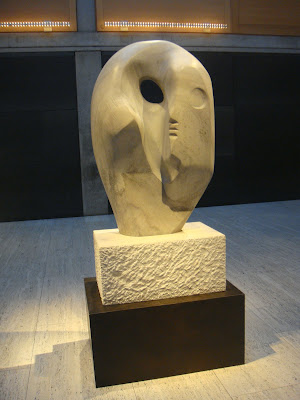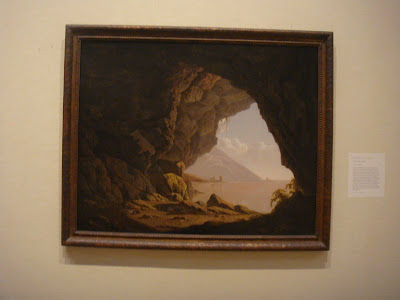

My visit to the Yale British Center for Art was on a Saturday afternoon. I had been there before, but the weekend had a lot more activity than my previous trips. I went alone for my first visit. The outside of steel and glass has a cold museum feel, but also is very grandiose. I like the entrance there. The corridor has a great sculpture right when you walk in.

It is open with stone walls and flooring, then turning into wood. It is very sophisticated and definitely reminds me of something the country of England would create. It has a royal British air to it. The front desk was very accommodating and gave me plenty of materials about the museum and exhibits.
The Yale Center for British Art was designed by an American architect named Louis I. Kahn and it was his final work. It is very geometric and designed around two open courtyards that bring in plenty of natural lighting. All the galleries are made of a mixture of natural materials: marble, oak and linen. Kahn’s desire was to create a space with as much natural lighting as possible and he does so with the courtyards, large windows and skylights that are on the top floor. The founder of the building was Paul Mellon. He was British born and went to Choate and Yale. He has an extensive list of education and philanthropy throughout England and America. His and his father’s love for art started them in collecting hundreds of pieces of British art and written works. In 1966, Mellon announced his gift of the museum, numerous works of art and endowment to establish the center.
The majority of the permanent collection was gathered by Paul Mellon. There is a vast amount of art that is landscapes, sport, early Victorian, Elizabethan, 16ht and 17th century, sea, women, Romantic, and more. There are specific sections that are for specific artists as well. Along with pieces of art, Mellon left a collection of books, manuscripts and works on paper. For a collection that was gathered by one man, it is definitely extensive and diverse. The special exhibit was “Adapting the Eye: An Archive of the British in India, 1770-1830.” There was also a film series of India on display.
The piece that I was drawn to was on the sunlit fourth floor. The Wright of Derby pieces caught my eye. Though the works are all detailed and well placed. I am not intrigued by Elizabethan art or any types of portraits from the time period. The art that caught my eye was by Joseph Wright of derby. He was born in England in 1734 and created landscapes and portraits. The collection was of colorful landscapes which as you walk alone the gallery, it slowly changes over to those types of works. But Wright’s pieces had a vivid color and contrasting light to them that the other pieces lacked. He is often an artist that is related to the Chiaroscuro effect. This is when an artist emphasizes the contrast of light and dark. He was a frequent contributor to plenty of British art societies and exhibitions.


The picture I chose was influenced by the time when Wright was living in Italy with his wife. From a distance, while in Naples, he witnessed the eruption of Mount Vesuvius. After moving back home to Derby, a vast amount of his paintings were influenced by this event. The piece is called Vesuvius from Posillipo and is oil painting on panel.


It has a great contrast of light and dark, colorful and neutral. The observer is looking from the bay out at the eruption. The reds around the mountain flood changing into beautiful pinks slowly morph into the blues of the sky. The mountain is offset to the right and the waters reflection gives opportunity for more colors in the piece. The bright colors are surrounded by billowing, gray smoke and the dark silhouette of boats and landscape. The pictures that I have taken do not do the colors justice.
Overall, the Yale Center for British Art is extensive, filled with natural lighting and has a beautiful amount of works. Paul Mellon did a fabulous job of creating British culture for the American public. Kahn compliments the art with grand galleries, natural elements and lighting and all in all the museums creates a wonderful experience for the visitors.
In my exhibit post I meant to say that I would be posting a paper and not a picture post! Those will come with my second visits to the two Yale galleries.
ReplyDelete